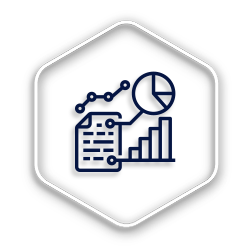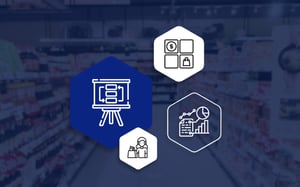Category management is the structured and collaborative process of managing product groups as strategic business units to improve category performance through efficient consumer response. However, applying the correct principles for category management is more complicated.
For example, data plays a large part when setting up the correct category management principles. So, when setting up the category management principles for a retail environment, it is critical to consider all the contributing factors.
Each plays a significant role in effectively managing categories.
Before we consider the principles of the different aspects of category management, we’d like to make three points. While a slight detour from the topic, they are still significant.
Firstly, specialised software doesn’t solve everything. By that, we mean you need more. Alongside software, you need proper methodologies, proper processes and talented people. You’d also need the necessary skills and resources.
Secondly, if you’re considering category management, you need executive-level buy-in. Since this affects so many different parts of your business, you must align from top to bottom. Also, true category management success comes from commitment.
Thirdly, if you’re a retailer, you need to be clear with your suppliers about how you'll collaborate. In saying that, we would suggest you have a structured formal approach. As part of this process, it is advisable to include a specialist third party such as DotActiv to assist in setting up this model.
About the contributors
Cheré Joubert joined DotActiv in 2019 as a space planner for the Health and Pharmacy Department at Dis-Chem. Since then, she has changed roles to cluster and assortment planner. She holds a BConsumer Science in Food Retail Management.
Sasha Anderson joined DotActiv in 2018. Since then, she has worked on various key accounts across the business. She currently works on the Dis-Chem account as a floor planner. She holds a BCom (Honours) in Marketing.
Suné Oosthuizen joined DotActiv in late 2019 as a space planner. She currently works on the Dis-Chem account in Johannesburg, creating data-driven planograms for the pharmacy retailer. She holds a BConsumer Science (Honours) in Clothing Retail Management.

What are key category management principles when it comes to planograms?
1. Always use data to build your planograms
Data is a vital category management principle that you need to utilise correctly to gain full benefits and ensure data-driven outcomes when managing any category.
So, what type of data do you need to build a planogram?
For one, you can use store data or market-related data. It includes market-related factors along with product information.
For example, you would need to include the product code, barcode, product description, brand and supplier information to identify products on the planogram. It also ensures that you merchandise the top performers in the category favourably, even out your days of supply and that you meet the target days of supply for the planogram. You would also need to provide and attach the correct images and dimensions to the products to illustrate where to place the products on the planogram.
Sales, units and gross profit data are also essential. It is because planograms are data-driven visual representations of where you should place products on the shelf according to their contribution within the category. Your sales data contributes to how you build your category, and how you would use it in conjunction with display hierarchies.
Your display hierarchies are also influenced by how the consumers shop the category, and how you view it in terms of strategies and sales contributions. That ensures your customers can shop the category and find what they want.
As for what would happen if you don't use data, it's simple:
By not using data to drive the build of your planogram, you will not assign space to a category accurately. What's more, you won't create planograms that improve the sales performance of your store. For example, shoppers who can't find what they are looking for in a store would not want to continue shopping there, and the retailer would lose business.
Other downfalls would be stock related issues such as a lack of stock of products that may be performing better than others or more stock than needed of underperformers, which results in you wasting your shelf space.
2. Use the merchandising principles set for your stores
Each retailer has a set of merchandising principles that you would need to follow to ensure that all stores are set to a certain standard.
For example, when you don't follow a high-risk category placement structure, it could result in health and safety issues.
Each retailer is different in terms of the perception they hold in a customer's mind and their product offerings to a customer. You know what works in your business in terms of how to group products, how products should appear across the aisles and throughout the whole store, and the needs of your customers
For example, let's consider pharmacy retailers. They offer medications, health products, beauty products and so on. Some of these product categories are not available in other retailers for example expensive perfumes or cosmetic products can not be purchased at a discount retailer.
Even though general merchandising principles can be useful in building planograms, it is crucial to use the specific principles set out by your business. That is to ensure that your planograms align with the image that you want to portray and ensure that the consumer can easily shop your stores.
It is vital that all the planograms portray a similar image and that everything is aligned across all of your stores.

What are key category management principles when it comes to assortment planning?
1. Your classifications need to be up-to-date and according to the hierarchy
Product classifications are a direct reflection of your chosen display hierarchy as well as how the customer shops the category.
Incorrect classifications could cause incorrect sales pulling through in the wrong categories. That would skew your data and have a long-lasting effect on the data you'd use to build your planograms.
You would need to update your classifications as the display hierarchy changes over time. Having up-to-date classifications makes it easier to determine like for like products, what purpose they serve, how they can be categorised and how they can be merchandised in a way that makes sense to the customer.
Classifications assist assortment planners in identifying like for like products in a ranging exercise. Checking that all classifications are done and updated is the first step when starting the assortment planning process. This is a critical step as the classifications ensure that all of your products have a place in the hierarchy.
Let’s say that you have a hand lotion called 'MY LOVEY' but you haven't classified it, it will either be left out as it seems that it should not be part of the range, or it will be ranged according to the description.
As for your hierarchy, it is the main driver of your classifications. It flows through your classifications of sub-categories, segments and so on.
The hierarchy illustrates the consumer decision tree, which then influences how you need to classify and build your planograms.
For example, if your customers are brand loyal, the brand needs to be above the sub-category level in the hierarchy and translates to the planogram being brand blocked.
When doing the classifications of products, you must make sure each level of the hierarchy is filled in, starting with Department and moving down to Category, Sub-Category, Segment and Sub-Segments as well as Brand.
Once complete, you can start with the rest of the category management process. An assortment analyst will use levels of the hierarchy to ensure that you complete ranging properly on all levels and product variants aren't missed. Meanwhile, a space planner will ensure that you merchandise your category correctly according to different levels of the hierarchy.
2. You need to determine your brand and store profile
Brand profiling relates to the Retailing Sales Price (RSP) per brand for your products in a category.
This relates to the customer's perception of the brand's positioning within the category relating to price and value for money.
For example, more expensive brands would be premium; brands in the middle price range would be mid-tier and cheaper products would be economy. You'd compare products according to the price per size. For example, Brand A is R9.99 for 50g (economy), Brand B is R12.99 for 50g (Mid-Tier), and Brand C is R18.99 for 50g (Premium).
Determining the brand profile helps you select the right assortment of products for the right cluster or stores.
For example, if grouped stores consist of an upmarket area, an upmarket clientele and based on the average spend, you can allocate a percentage of the products to meet a target. The cluster or store might be a premium store and, according to the average spend, have a mix of 50% premium and 50% mid-tier brands. That indicates that some customers may purchase Brand B or Brand C instead of Brand A.
This data would assist an assortment planner to meet the brand profile requirement for the cluster and ensure that they include at least 50% premium and 50% mid-tier brands in the assortment for those stores.
You can use any results from a brand profiling exercise in clustering to confirm the profile of different store clusters. For example, you’d add a category with more sales toward the economy brands than the premium into the economy cluster.
Store profiles, meanwhile, allow you to identify which of your stores should be economy, mid-tier and premium. You'd base the decision on various factors, including the LSM of your shoppers and the location of the store (areas that are low, middle or high income). The purpose of determining your store’s profile is to ensure that you sell the right product assortment to the right target market at the right place. This will assist you to offer the right price point products to the consumer of that profile.
Store profiles also help you to identify clusters according to what they may be considered to be on a store level (economy, economy_mid-tier, mid-tier, mid-tier_premium or premium) for a particular category. You can use this information during assortment planning in allocating products on a category level to meet the needs of customers at a store level.

What are key category management principles when it comes to floor planning?
1. Always ensure your CAD/DXF file is up-to-date
You usually build a floor plan on an existing CAD/DXF file. It is critical to have an up-to-date CAD/DXF file as all the work completed is based on the layout and detail set in the file, such as store entrance, set fixtures or obstructions, etc.
If the file is out of date and you have completed your floor plan on inaccurate layouts, it will result in an inaccuracy that you can not implement. This will result in a floor planner needing to do the work multiple times, which reduces their efficiency and wastes valuable time.
2. You must ensure you use the provided departmental flows
A departmental flow is an illustration of how a department in your store should flow for customers to find what they want in the same aisle or encourage them to add products to their basket.
You can also describe it as how you would group categories that you would consume in conjunction with each other.
For example, you'd place milk next to or opposite cereals as they are frequently consumed together and purchased together. Keeping them close to each other makes it easier for customers to add to their basket and have a more pleasant shopping experience.
You should encourage your customers to shop on both sides of the aisle and having relating categories near each other can help. It also ensures uniformity in the store layouts of your departments as your customers will know where to look for certain products.
As for why a departmental flow is so important, it is an easy explanation.
Departmental flows ensure consistency among the departments. That’s even if stores are different sizes and the departments have different space allocations on the floor plan.
For example, if the vitamins department usually is at the back of the store, your customers will not be confused when shopping for these products in a different store.
You must establish a set flow of the store to ensure that frequently shopped categories pull the customer through the whole store. That may increase revenue for you as customers realise they need more than they initially came in for and add to their basket.

What are key category management principles when it comes to clustering?
1. It is advisable for your clustering to be category-based
Category-based results are not aimed at creating clusters and planograms for each store respectively. Instead, you can use it to group stores based on similarities in certain predetermined fields.
Ranging categories is a more holistic approach to ensure product offering uniformity across all of your stores.
You can cater to your customer's needs in every store and you are not limited to what your store offers.
For example, a 4-drop gondola for hair colour will have a core range based on contributions of the products or brands in that category. Meanwhile, a 5-drop may have the core range and a bit more to accommodate stores that can implement a 5-drop as the store may be bigger or because the category contributes more sales in this store and therefore justifies more shelf space.
This approach is the best option for you if you have many store locations and allows you to provide for your customers if you have more than one target market. That's in opposition to a store-based cluster, which can help you cater to a location-related market.
2. Your clustering process should be full automated
To fully automate the clustering process is to eliminate additional time taken to do the process manually, which could result in mistakes. Automation assists in simplifying the task of clustering by using algorithms and machine learning to reduce the chances of error and to give you a more accurate result in the long run.
The ability to change, relook and adjust as needed without having to manually update or change the data is a benefit. That's because the process is linked to other aspects of the software. Information is updated at the click of a button as opposed to being manually inserted elsewhere after the process has been completed.
For example, DotActiv's Cluster Optimizer tool can update cluster maintenance, which can then feed through to range maintenance.
That should be enough reason why you should not do clustering manually. Another reason is that conducting a clustering exercise manually is time-consuming and can easily leave room for errors.
Using the software for a fully automated process ensures that you can update your ranges and link your planograms. If the work is done manually - it is very time-consuming to get everything into place that should be taken into account and also takes a lot of time to make the necessary updates to the ranges.
Conclusion
The above-stated principles are vital when managing a category efficiently. Be it by space planning, assortment planning, floor planning or clustering. Applying the correct category management principles will ensure an optimal management experience and ultimately lead to a successful retail or business environment.
Looking for advice or need a category management solution that can help your business? Visit our online store here for more information or book a custom exploratory consultation.


